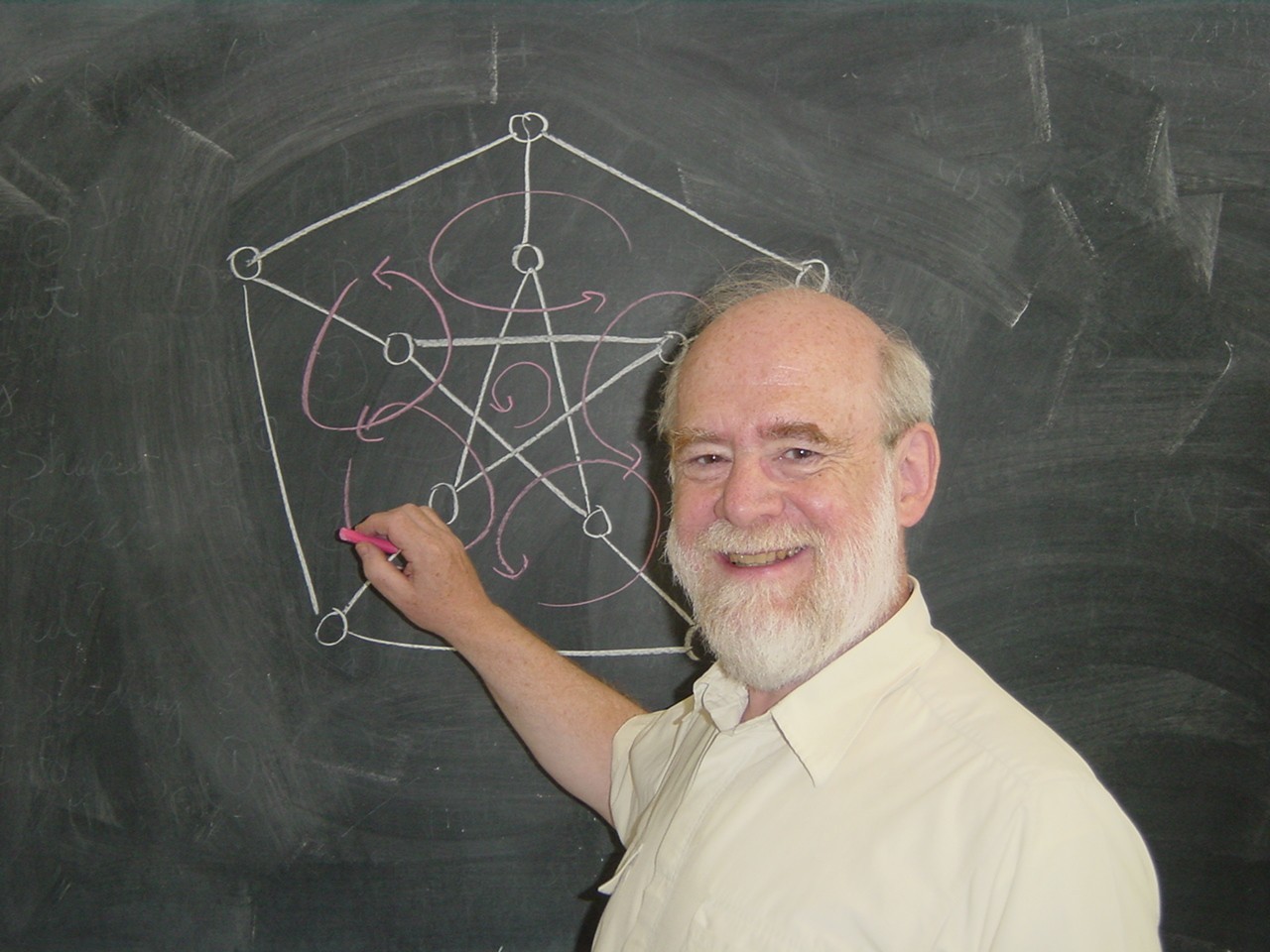 |
Joseph Douglas
(Joe) HORTON
Professor |
Address :
Tel :
Fax :
office :
email : |
Faculty of Computer Science,
University of New Brunswick
P.O. Box 4400, Fredericton,
N.B. CANADA
(506) 447-3336
(506) 453-3566
E12c, Head Hall
jdh@unb.ca |

|
| Present
Research Activities |
Research Interests:Design and analysis of algorithms,
graph theory, combinatorics, automated reasoning, network
scheduling, complexity .... My most recent research interest is
the Simulation Of Consciousness In Artifical Life : the SOCIAL
project. Here is the tech-report
which I wrote to start the project. I now (2011) have three
graduate students working on it.
Topics for CS4997: An incomplete list 2010:
- Develop an artificial universe inhabited by "bugs" that
evolve new attributes. This may require working as part of a team
with graduate students.
- Enumerate all "pedigrees" (family trees) with specified
characteristics. We would like to be able to generate such
pedigrees with equal probability to use in running experiments of
haplotype determination algorithms and finding
mutations/crossovers, given genotype data of the individuals.
- Consider how to find the minimum cycle base of a directed graph.
- Implement a new algorithm to solve the SAT problem, or rather
the UNSAT problem. The algorithm I have in mind is related to
the merge depth of proofs (see below). If it works well, maybe
we could enter the SAT competition.
- Develop some interactive game that explores some unusual
physical universe, such as: four dimensions, special relativity
(ie slow speed of light), or a universe in which quantum
mechanics is apparent.
Clause trees: Work with Bruce
Spencer. We have developed a new data structure for automated
reasoning, the clause tree. Many old algorithms for automated
reasoning become easier to understand when viewed as manipulating
clause trees. Moreover new tighter algorithms can be defined. The
method is useful in solving any problem to which automated
reasoning can be applied, from an improved automated theorem
proving tool to aid mathematicians (probable), to helping prove
programs correct (a long shot). It may be beneficial in proving
the security levels of computer systems.
An introduction to clause trees is given in our 1997 paper in
Artificial Intelligence. Some details about how to
implement them are given in our 2000 paper in the Journal of
Automated Reasoning. Implementation seems to be a big problem;
we do not have a good efficient implementation.
Complexity:I have a incomplete paper using clause
trees. The main results so far are:
- Define merge depth for clause trees and unsatisfiable
sets of clauses. A clause tree has merge depth d if the longest
chain of merge paths that precede one another is length d. A set
of clauses has merge depth d if the closed clause tree on the set
with the smallest merge depth has merge depth d.
- Exact exponential bounds on the size of the smallest clause
tree on a minimal unsatisfiable set of clauses, given the number
of variables and the merge depth of the set.
- The merge depth of clauses can be linear in the number of
variables plus number of clauses, using results from
Chvatal-Szemeredi, JACM vol.35 pp759-768, 1988. This gives a
somewhat different proof that treelike resolution is
exponential.
- A simple observation is that the length of the smallest
treelike extended resolution proof is polynomial in the length of
the smallest extended resolution proof.
The ambitious goal is to show that the size of the smallest
proof using extended resolution is exponential (or not).
Haplotype determination:
My most recent paper is joint work with my colleague
Patricia Evans, and her doctoral student Duong Doan. We have a
fast implemented algorithm to determine the haplotypes given the
genotype data for the members of an extended family of dyploid
individuals. There are many ways in which this research can be
extended.
Cycle bases: I have had several results on finding the
minimum cycle bases of graphs. The directed case problem has
also been considered, but I think that the extension to directed
graphs should be done differently than what is in the literature.
My original field of research was combinatorial design, an
area in which I rarely publish anymore. Three of my papers were
published in 1991 in this area.
After completing my Ph.D., I became very interested in graph
theory. I found the first known non-hamilton bipartite cubic
graph, which was called the Horton graph in the textbook by Bondy
and Murty, and the first hypotraceable graph. Perhaps my best
work in this area was with Izak Bouwer on symmetric graphs. The
joint work with my masters student Kyriakos Kilakos on minimum
edge dominating sets is cited more often.
After coming to UNB in 1981, I became interested in Algorithm
Analysis. The most important result here, and the paper that has
generated the most citations for me, has been the discovery of a
polynomial-time algorithm to find the shortest cycle basis of
graph. This result has applications in many areas of Mathematics,
Engineering and the Sciences.
The other paper of mine that has generated a large number of
citations was a partial solution to an old combinatorial geometry
problem. I constructed an infinite set of points in the plane in
which any set of seven points that formed a convex 7-gon must
contain other points inside the 7-gon. This set of points is now
often called the horton set.
-
J.D. Horton, R.C. Mullin, and R.G. Stanton, 1971, "A Recursive Construction
for Room Designs", Aequationes Mathematicae 6, 39-45.
-
J.D. Horton, 1974, "Sublatin Squares and Incomplete Orthogonal Arrays",
J. Combinatorial Theory A 16, 23-33.
-
J.D. Horton, 1981, "Room Designs and One-Factorizations", Aequationes Mathematicae
22, 56-63.
-
J.D. Horton, 1983, "Sets with no empty convex 7-gons", Canadian Mathematical
Bulletin, 26, 482-484.
-
J.D. Horton, 1987, "A Polynomial Time Algorithm to Find the Shortest Cycle
Basis of a Graph", SIAM J. on Computing, 16, 358-366.
-
J.D. Horton and I. Z. Bouwer, 1991, "Symmetric Y-graphs and H-graphs",
J. Combinatorial Theory B, 53, 114-129.
-
J. D. Horton and K. Kilakos, 1993, "Minimum Edge Dominating Sets", SIAM
J. Discrete Math, 6, 375-387.
-
J. D. Horton, R. Harland, E. Ashby, R. H. Cooper, W. F. Hyslop, B. G. Nickerson,
W. M. Stewart, O. K. Ward, 1993,"The Cascade Vulnerability Problem", J.
Computer Security, 2, 279-290.
-
J. D. Horton and Bruce Spencer, 1997, "Clause trees: a tool for understanding
and implementing resolution in automated reasoning", Artificial Intelligence,
92, 25-89.
- Bruce Spencer and J. D. Horton, 2000, Efficient Algorithms to Detect and Restore Minimality, an Extension of the Regular Restriction of Resolution, Journal of Automated Reasoning, 25(2000), 1-34.
- Joseph D. Horton, Alejandro Lopez-Ortiz, 2003, On the
Number of Distributed Measurement Points for Network Tomography,
IMC-03, Proceedings ACM SIGCOMM Conference on Internet
Measurement held in Miami, Florida, October 27-29, 2003,
204-209.
- Duong Doan, Patricia Evans, and Joseph D. Horton, A
Near-Linear Time Algorithm for Haplotype Determination on General
Pedigrees, submitted June 15, 2009 (41 pages).
- List of Publications
- In the Fall term 2011, I am teaching
CS4935/6991,
advanced algorithms
- In the winter of 2012 I will be teaching MATH3343, Networks and graphs.
- Intersession 2012 I teach CS2333
Computability and Formal Languages.
-
The Canadian Mathematical Society (life member)
-
Association for Computing Machinery - SIGACT
-
Foundation Fellow of the Institute of Combinatorics and its Applications
-
Association for the Advancement of Artificial Intelligence (life member)
| Non-Professional
Activities |
-
Hold the rank of FIDE Master at chess (Atlantic Canada Champion
1984, 1992, 1996). In terms of quality of play, my best
tournament was in the Canadian Closed Championship 1984, although
I ended with a slightly negative score (6-8). My best result was in
1992 when I scored fifty percent, but had two lucky wins. I was
totally crushed in 1996.
-
I sing in choirs and a barbershop chorus.
- I used to play the
piano and recorder.
Other
Research Activities
UNB Homepage
CS Homepage
Document: http://www.cs.unb.ca/profs/horton/
Last Revision: Nov. 15, 2011.

